Unlike most other brands, Wissmann has been offering a complete boiler control system for several years, both via GSM (SMS) and via the Internet.
This is often a strong argument in favor of choosing Viessmann boilers.
Viessmann has something that others don't. Working and reliable system remote control the entire heating system. Those. You can control not only the boiler, but also a solar power plant and a geothermal heat pump.
All these remote boiler control functions are implemented by the Vitocom module
An interesting feature is that the boiler can independently send messages about any problem directly to the service department.
First option: The house has a GSM/SMS telephone connection
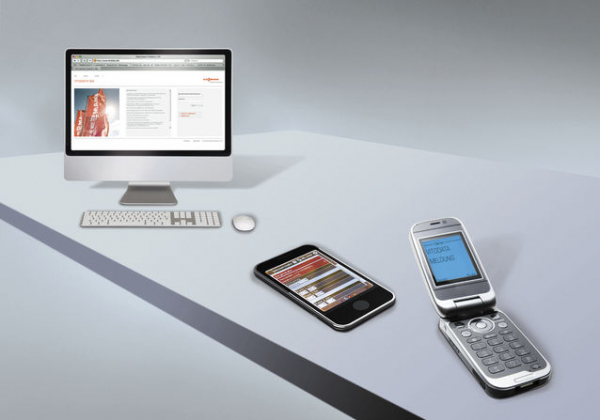
The Viessmann boiler can be controlled either by a regular landline phone or by cell phone.
If desired, you can use SMS.
Main features of the Vitocom control system:
- Switching the boiler operating mode (for example, switch to standby mode, or turn on the boiler in advance on Friday evening)
- Request boiler status
- Obtaining fault signal and error code information ( you can specify two numbers for SMS - for example, the owner’s number and the service number)
- Request SIM card balance
Viessmann Vitocom 100, type gsm2 .
Second option: there is constant Internet in the cottage
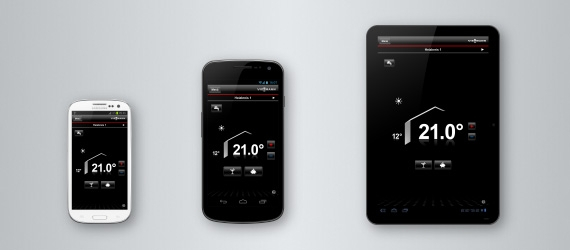
If you have the Internet, then managing the boiler will be much more convenient and easier.
You can access the website www.vitodata100.com from any device (PC, laptop, tablet, smartphone) and conveniently configure all the necessary modes or parameters.
Each heating circuit will be under your control.
Additional features:
- setting the heating program;
- setting the temperature in the room;
- setting cooking temperature hot water;
- viewing temperature sensor readings and the status of the heating installation;
analysis of the efficiency of a heating installation ( especially when using solar collectors).
Telecommunications module required Viessmann Vitocom 100, type LAN1 .
Thanks to the development of new technologies, homeowners have the opportunity to monitor and remotely control their heating country house via a GSM cellular network or via the Internet. Moreover, such control can be organized over almost any heating equipment. In addition, most such systems support several additional useful functions. More details about the work automatic systems You can learn about monitoring and control of heating of private houses from this article.
How does the monitoring and control unit work?
The basis of the system is a special electronic unit that has 1 or several slots (sockets) for installing regular SIM cards for cellular communications. More advanced models are also equipped with a LAN connector, where an Internet connection cable is connected. Also connected to the device various sensors– temperature, pressure, fire alarm and so on. The electronic unit is connected to the boiler and other home heating or alarm systems using separate cables.
The electronic heating control unit works as follows. After initial setup, the processor “knows” normal operating conditions heating system. When any of the sensors detects a violation of these conditions, for example, a decrease in temperature in country house, then the processor commands the GSM module to send an informative SMS to the homeowner’s phone number. The latter can check the readings of all sensors at any time by sending an SMS with the corresponding content to the SIM card of the control unit.

In normal mode, the automated control unit of the heating system acts as a remote control with a thermostat and monitors the maintenance of the set temperature in the rooms. The owner of the house can use SMS to give a command to raise or lower this temperature, then the processor of the control unit transmits the command to the gas boiler controller to turn the burner on or off. By the way, you can control boilers using any fuel equipped with a controller.
Important. Remotely control the simplest energy-independent heat generators that do not have electronic systems, it won't work. Their work can only be monitored using sensors and if an emergency situation occurs, some measures can be taken. physical actions on one's own.
Control via the Internet occurs in the same way, only through a different communication channel between the homeowner and the electronic unit in the house. To operate the system, a special application is installed on your smartphone, which monitors all parameters in real time. This information is also available from any computer; you just need to log in to the manufacturer’s website. Boilers from European manufacturers can optionally be equipped with similar heating control systems.
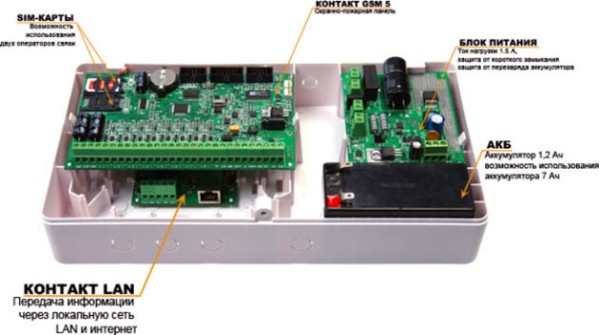
For example, VIESSMANN heat generators are equipped with a “native” Vitocom 100 unit, compatible with Vitotronic controllers. IN Russian Federation the most common remote GSM control modules are KCITAL and MASTERSENSOR domestic production. They are quite reliable and are in an affordable price range.
Basic and additional functions
The most simple system, which is used to control heating in a country house via GSM, has the following set of basic functions:
- control over the temperature of the air in the house and the coolant;
- generating a daily report automatically;
- monitoring the presence of 220 volt voltage in the home network;
- turning off and on several electrical appliances on command or in the event of an accident, including the boiler;
- maintaining the set temperature in the house and changing it remotely;
- the ability to connect your own battery so as not to depend on external sources.
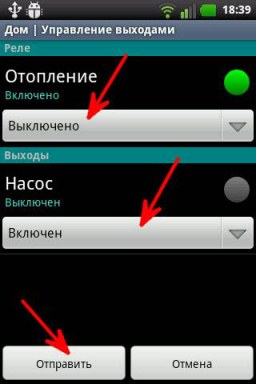
Quantity additional functions devices is limited by the number of connected sensors and executive relays of the electronic heating control unit itself. XITAL devices have 3 relays, you can connect a heat generator and 2 more units of any other equipment, at least a circulation pump and an alarm system. The number of connected sensors is from 4 to 12, which makes it possible to implement the following functions:
- monitoring pressure in the heating system with a solid fuel boiler and turning it off;
- control over the level of diesel or other liquid fuel in the supply tank;
- tracking the number of pellets in the hopper of a pellet heating unit;
- perimeter security with motion sensors;
- activation of the fire alarm based on signals from smoke and flame sensors;
- shutting off the water line using an electric valve based on a signal from a leakage sensor;
- control any household appliances remotely using a cell phone.
Note. In addition, the XITAL units have a built-in microphone, which allows you to listen to the room where it is installed from a distance via the telephone.
All of the above actions are accompanied by sending an SMS to the homeowner and to 9 more numbers, which he will enter into the device’s memory in advance. As mentioned above, the user can control the heating of the house and several other systems by sending voice or SMS commands.
A simple automated unit for monitoring and controlling a heating system of the XITAL type can be installed with your own hands if you carefully understand the operating instructions. Mounting the device and installing the sensors is not particularly difficult, as is their connection. The included cables are long enough to carry the sensors throughout your home. But there are nuances that must be taken into account when organizing heating control.
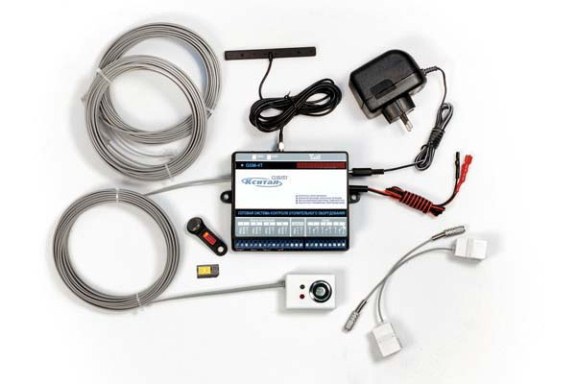
The first is the presence of good GSM coverage at your place of residence. It happens that in one place there is coverage from several cellular operators, but none of them works reliably. In this case, KCITAL is equipped with two slots for SIM cards to duplicate messages. The second caveat is that before inserting the SIM card into the slot, you must contact the operator and disable the sending of any advertising content in the form of SMS. Such messages arriving at the device number may cause malfunctions in its operation.
Advice. It is better to purchase a new SIM card for the heating control unit with a “clean” history of use.
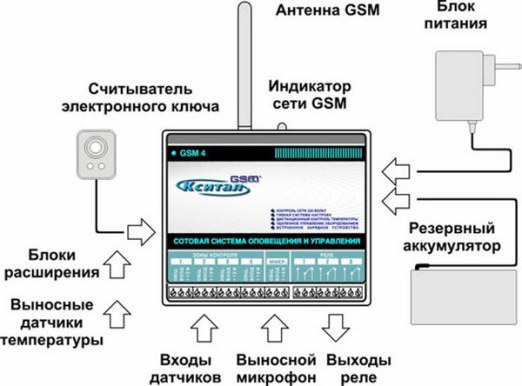
The same recommendations can be given regarding devices that interact with the owner via the Internet. The cable connected to the LAN input should not come from a router or modem powered by a 220 V network. Otherwise, if there is a power outage, the communication channel will also be lost. The devices themselves must always have their own battery, which can ensure their operation for at least 3 days. Detailed recommendations installation instructions for XITAL can be obtained by watching the video:
Conclusion
Installation of blocks remote control heating and other important systems a country house will not only improve the comfort of living and ease of use. This means you can use energy wisely by lowering the temperature and turning off unnecessary equipment when no one is home. Not to mention preventing various emergency situations or fires in your absence.
New remote control technologies make it possible, using GSM systems, to use previously inaccessible methods of monitoring the operation of many units, in particular the heating boiler. First of all, you should decide whether remote control of the GSM boiler is really necessary.
In many cases, you can get by with Salus programmable or daily thermostats, which have a wide range of boiler control, as well as all types of heating: radiator, floor and convection. Wired and wireless modules are available that can significantly increase comfort and save energy resources.
Remote heating control tasks
A private home needs constant supervision, and heating is the biggest concern. Many people do not live in a country house in winter and are forced to leave the boiler running so as not to defrost the system. This consumes a lot of fuel and you have to look for ways to save it.
Automated systems allow you to control autonomous heating. They also need control, which can now be done using a smartphone or mobile phone. With the increasing need for comfort and changing standards for heating equipment in an individual home, GSM - remote control of the boiler is required.
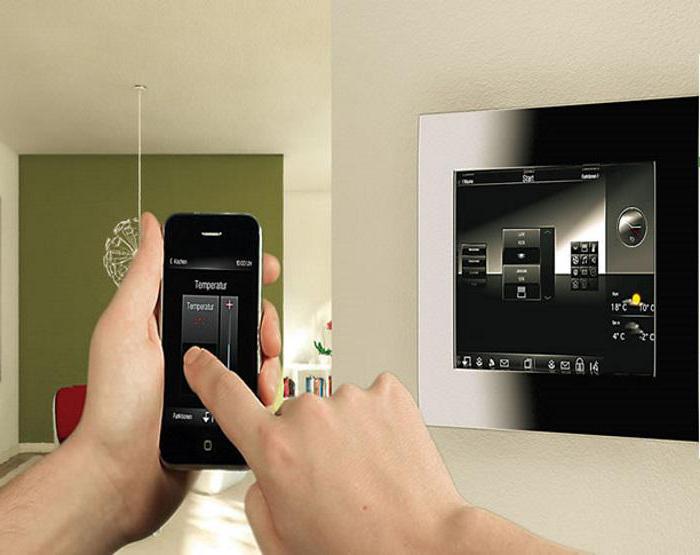
In addition to the heating system, there are many other household appliances, with which it can work. It is especially important to connect security system, which will provide independent monitoring of the house without the help of special services.
Advantages of a cell phone control system
To have a complete understanding of the possibilities of using remote heating control systems, you need to know their advantages:
- creating additional comfort;
- ensuring economical operation of the boiler, due to which energy costs are reduced by up to 50%;
- receiving information by phone about emergency situations, power outage or gas supply, coolant leak;
- reducing the heating load increases the service life of the equipment;
- engineering systems are gradually being integrated into a common network, which reduces maintenance costs and creates special comfort" smart home".
To control a boiler via GSM, you do not have to be a professional. You just need to know the basic principles and basic rules of working with it.
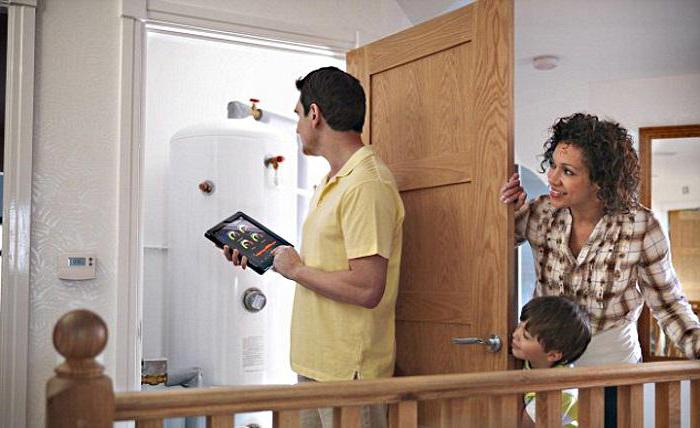
It is not necessary to thoroughly understand all the intricacies of setting up and servicing equipment. In any case, it is installed by specialists and, if problems arise, they will provide the necessary advice.
GSM system capabilities
GSM - heating boiler control - performs the following functions.
- Maintaining normal operation of the boiler and key elements of the heating system of the entire house.
- Setting individual temperatures in different rooms.
- Protection of the heating system from defrosting at a distance.
- Remote activation of the boiler before visiting the house on a weekend.
- Monitoring and diagnosing the operation of autonomous heating via mobile communications.
- Creating a Lean thermal regime in the house, set to low power when everyone is away, and then back to normal before returning.
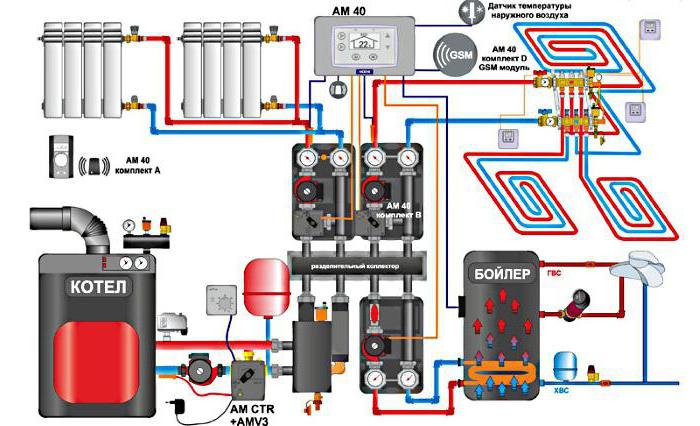
Heating can be controlled remotely not only via mobile communications, but also via the Internet.
Principles of organizing remote heating control
A modern GSM boiler control system in a private home is a complex electronic complex where all elements are combined into a common network. The parameters are regulated by built-in control units. The heating components must be connected to the electronic control unit, and this, in turn, to the user.
The main properties of a remote heating control system are:
- connection of electric thermostats and sensors with boiler automation;
- adaptation of a control system with autonomous heat supply;
- the possibility of influencing heating parameters when exposed to external conditions: climate, temperature in the house, coolant leakage and other emergency situations;
- the ability to control heating from a distance in order to create the necessary microclimate or an economical operating mode in the absence of the owners.
Controllers are installed in critical areas of the boiler, through which parameters are changed. All of them are connected to an external control unit - a programmer or thermostat. It can be configured manually via the remote control, but it can also be controlled via the Internet or mobile phone.
Programmer functionality
- The number of connected components (control circuits) is from 1 to 12.
- Setting modes - normal, comfortable, economical.
- Additional control module - transmission of information by phone via SMS about the temperature of the coolant, the occurrence of an accident, etc.
- The presence of wired channels or wireless communication between heating components.
GSM module functionality
The boiler control module is not included in the package; it must be purchased separately and then connected to a controller, for example, Defro St 57 Lux. After setup, you will be able to receive information in the form of SMS about boiler parameters and emergency situations.
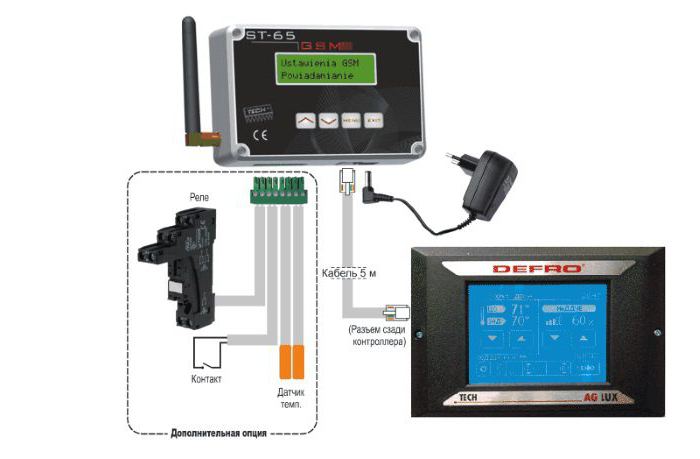
Reverse control is also carried out by sending SMS of a given format. They allow you to adjust the temperature of the boiler coolant and in the heating circuits, start the boiler after shutdown, etc. Some models provide a function for activating the command after a certain time.
Module functionality:
- work for 1, 2 or more phone numbers;
- receiving data from 4 or more channels, for example, about the temperature of the boiler, boiler, heated floor and room;
- remote control via SMS messages of the temperature of the coolant and water in the boiler;
- receiving information about problems: overheating, failure to operate, etc.;
- connection to another circuit, such as a gate opener or burglar alarm, lighting, watering plants, etc.;
- independent operation during a power outage;
- use of a PIN code to prevent third parties from connecting.
The module is connected to the boiler controller via a connector. They are also supplied with mains power. A SIM card is installed and the numbers of two telephones are entered. They will transmit information in the form of SMS messages. To control the boiler, commands are issued in the form of digital sets. In this case, a response message about completion or an error is received if the code is chosen incorrectly.
Important! For trouble-free operation of the boiler, together with remote control, it is necessary to have auxiliary elements: coolant flow control devices, sensors, safety valves.
How does the GSM module work?
The functionality of each module is limited and determined by the following factors:
- number of channels and sensors;
- level of management and control;
- possibility of regulation.
Sensors monitor temperature, pressure and presence carbon monoxide. Suitable for most modules analog sensors, producing signals of a certain level. Digital control is more suitable for connecting security alarms or household appliances equipped with a USB, RS-485 or RS-232 interface. Users note the appearance of false alarms from infrared motion sensors when the heating is on.
To control the operation of the boiler via feedback Most often, relay blocks are used that connect power to a gas boiler or switch modes if there are corresponding terminals.
GSM boiler control with a minimum set of module functions provides control and transmission of readings from coolant temperature sensors, indoors and outdoors. Using these data, you can evaluate the quality of heating operation.
The module sends a message to the user in the following cases.
- Sensor readings are transmitted upon request.
- The readings are outside the established limits.
The maximum and minimum permissible parameter values are set in advance. When they go beyond the range, the user receives an SMS message about this. Typically, the coolant temperature is set within 50-90 °C. If the temperature drops below 50 °C, it means that the boiler is not heating, and the equipment must be checked to ensure that the system does not freeze.
Modern modifications of GSM modules, using special applications, can display statistics on boiler operation in the form of creating time graphs, sending important messages and boiler operating parameters.
Electric boiler control
It is easy to connect GSM - control of the Protherm, "Evan" boiler and other units that run on electricity. The module operates from its own power source during a power outage. In the absence of electricity, it switches to operation in economy mode with some functionality limitations. When power is restored, it reboots on its own, and this can also be done remotely. When the electricity is turned off, the GSM boiler control continues and the module will give readings and the boiler parameters will change. The user will not receive false information about a system malfunction, since he will also receive information about a power failure over the phone.
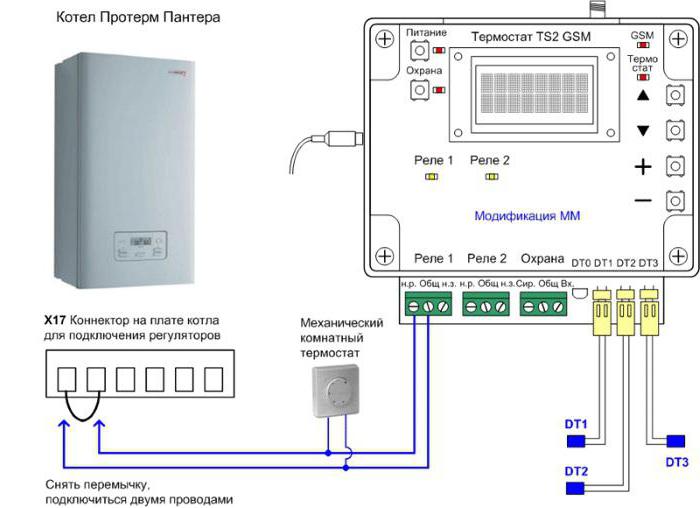
The device is connected to the boiler automation system, then, depending on the temperature sensor readings, the module relay in the room turns on, which is a command to supply voltage to the boiler heating elements. When the temperature in the room reaches the set value, the relay turns off and heating stops.
Costs for purchasing a GSM module
The boiler sometimes costs more than the unit itself, since the devices have recently appeared on the market. With mass distribution, they will, of course, become cheaper, but currently you have to pay $150-200 for them.
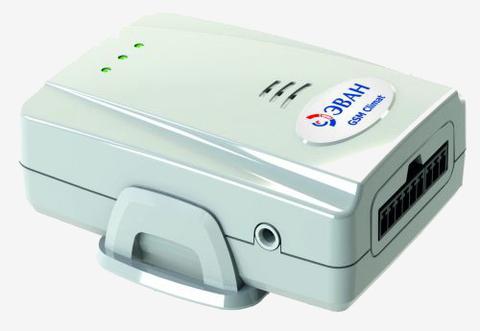
Conclusion
GSM boiler control allows you to increase living comfort, save on energy, eliminate operational failures and prevent accidents. When expanding the functionality of GSM modules, the costs for them pay off even now.
Content
Any heating system is equipped with control components. Protozoa mechanical devices allow you to maintain stability of the pressure in the circuit and the temperature of the coolant, electronic units with a stationary or remote control are able to change the operating mode of the system in accordance with the programmed or weather conditions. Today, another step forward has been taken - an electronic unit equipped with a GSM module allows for remote control of heating at any distance using a regular smartphone or mobile phone.
Heating control in a country house via GSM
Features of remote control
Heating control in a country house via GSM or via the Internet will be appreciated by the owners country houses or cottages designed for year-round use. If you have to leave the house unattended for a long time, concerns arise about the functioning of the heating system - for example, if the boiler goes out for some reason and does not turn on automatically, the system will freeze. This is fraught with depressurization of the circuit and the need to seriously invest in repairs.
Remote heating control has a number of advantages:
- due to operation in an economical mode, energy costs are reduced and the life of the equipment is extended, since it wears out less under reduced loads;
- the heating system can be included in the general network of the house, created for engineering systems- this will reduce the total costs of their operation.
Boiler control, both via GSM (SMS) and via the Internet, makes it possible:
- monitor the maintenance of the standard operating mode of the autonomous heating system with uniform heating of the entire house;
- if necessary, provide selective heating of rooms in accordance with personal preferences;
- prevent freezing of the heating system pipeline during a long absence of owners in the cold months;
- switch the heating system from economy mode to standard mode in advance, so that when the owners arrive, the cottage or country house was warmed up;
- monitor the condition and functioning of the heating system online and promptly receive information about problems.
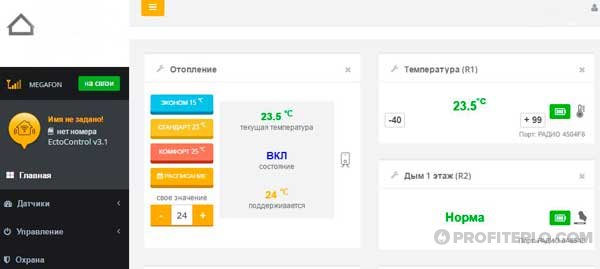 Screenshot from personal account GSM heating control controller
Screenshot from personal account GSM heating control controller An autonomous heating control system can be the first step towards creating a “smart home” and providing the most comfortable living conditions.
Which systems can be controlled remotely?
Automatic control heating is used for two-pipe autonomous systems with a membrane expansion tank and a pump for forced supply of coolant into the circuit. It is especially effective to control a system where each heating device is connected separately, through a distribution comb - a manifold. The system may include circuits with radiators and warm water floors.
The system is necessarily equipped with a safety unit, which operates automatically and prevents depressurization of the boiler water jacket and heating circuit due to excess pressure. Excess pressure is released through the emergency valve.
Additionally, equipment is installed that allows you to control the system - temperature and pressure sensors, devices that allow you to regulate coolant flow, controllers, and tools for creating a unified information network.
Weather-compensating system
Controlling a heating boiler is more effective if, in addition to temperature sensors installed in heated rooms, a device for measuring outdoor air temperature is added. This option provides precise temperature control and makes it possible to configure the system so that it independently adapts to changing weather conditions.
As a result, when it gets colder, the radiators will heat up more strongly, and when it warms up, they will turn into energy saving mode. This not only helps save energy, but also reduces the inertia of the heating system.
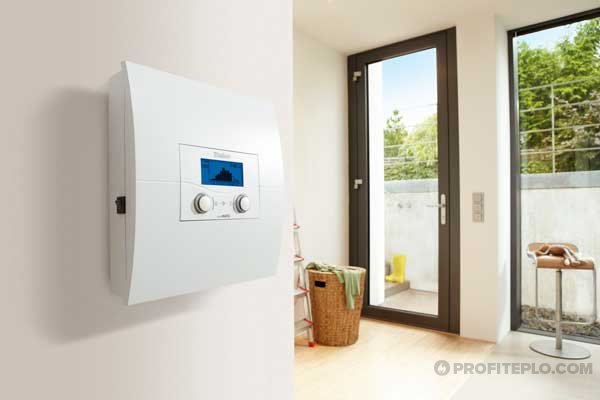 Wall-mounted weather-compensated heating controller for heating system control
Wall-mounted weather-compensated heating controller for heating system control Flexible zone control provides comfortable conditions for people, taking into account the situation: for example, if there are many people in a room, it quickly becomes hot as bodies radiate heat. The temperature sensor in the room reacts to an increase in air temperature, as a result of which the heating of the radiators in this room is reduced to an optimal level.
Typically, a weather-compensated system is configured to automatically turn off the boiler if the outside temperature reaches a preset level. Wireless and remote control systems are ideally combined with weather-dependent automation - the operation of the system does not require constant human intervention; it is enough to make adjustments to the operating mode as needed.
Types of systems
If you have a need to remotely control the heating of a country house, you need to choose one of two systems:
- the equipment set includes an Internet gateway, which requires Wi-Fi router and connection to the Internet;
- The equipment package includes a GSM module that controls the boiler unit, which requires its own SIM card for mobile communications.
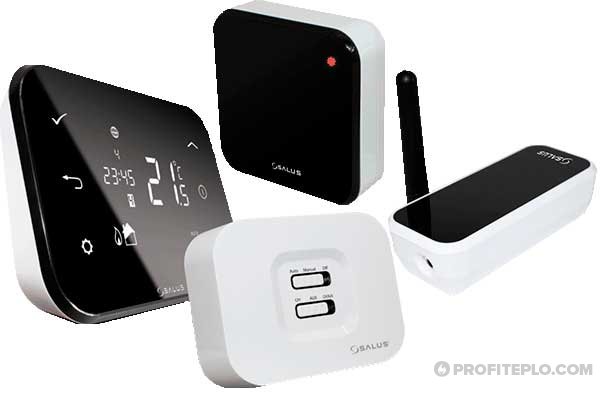 Remote heating control system
Remote heating control system We manage via the Internet
If the dacha or cottage is connected to an Internet provider or is used wireless communication, and you have a router (Wi-Fi router), then it makes sense to provide remote control of the boiler using special equipment.
In addition to the Internet gateway, which connects to the router, the kit includes a boiler receiver and a two-channel room thermostat with a programmer that allows you to set the weekly operating mode of the boiler unit, and a control panel.
Heating control via the Internet allows:
- adjust the operation of the gas boiler and pumping unit;
- change the operating mode in several heating zones independently of each other;
- regulate the functioning of the hot water supply system;
- monitor compliance with the programmed temperature regime for a day or week for each room;
- install energy-saving modes.
For remote control, a communication system between control and monitoring devices is used. The user must have a personal computer, tablet or smartphone. Thanks to the Internet, it exchanges signals with the router, which, in turn, communicates with the thermostat that controls the boiler through the receiver.
 Control your heating system via the Internet using a PC, phone or tablet
Control your heating system via the Internet using a PC, phone or tablet This wireless system boiler control, communication is via radio channel - no need to connect a cable to the thermostat. Programming the thermostat (setting the operating mode for a day or a week) is performed from the control panel of the device. This can also be done from a smartphone by installing the appropriate mobile application, or from a personal computer via an Internet browser.
Extended equipment with an Internet gateway allows for remote management auxiliary equipment for heating - oil radiator, water or electric heated floor, etc.
Controlling the temperature in your home using the Internet does not require a dedicated IP address; you can use mobile Internet from any operator. Users are connected to the system mobile devices on iOS or Android.
We control using mobile GSM
An alternative to a complex with an Internet gateway is a GSM boiler control module. This is a compact device into which a SIM card is installed - the choice of telecom operator does not matter, but it must provide high-quality signal reception. The GSM heating control module allows the user to make the necessary adjustments to the operation of the system at any time and at any distance - to do this, it is enough to use any phone (mobile, satellite or fixed line), as well as a stationary PC, laptop or tablet.
Controlling heating in a country house via GSM requires installation of a special mobile application on the user’s phone - versions are available for different operating systems - Windows Phone, iOs, Android. Thanks to the mobile application, almost all parameters of the heat generator can be adjusted remotely.
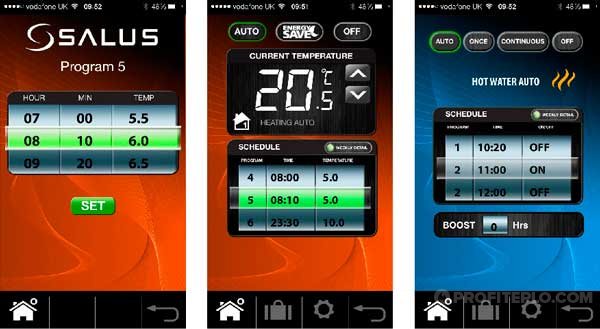 We control the heating remotely using an Android phone
We control the heating remotely using an Android phone Depending on the settings made, information from the GSM module will be sent to the user’s phone in the form of SMS messages or phone calls. For GSM remote control gas boiler the module sends information about the functioning of the heating system, instructions for adjusting the settings of the boiler unit. The GSM boiler control device is a portable computer that processes data received from external sensors and has the ability to change the operating parameters of the heat generator.
Pay attention! A GSM heating control unit during operation consumes up to 100 MB of mobile Internet traffic per month. In order for the device to function uninterruptedly, and the user can check the status of the heating system at any time, it is recommended to regularly top up the balance by setting up an automatic payment, or installing a SIM card with an unlimited tariff in the module.
To control heating using your phone, just log into the cloud service on the module manufacturer’s website to control the system without sending phone calls and SMS.
GSM heating control is designed to function:
- in automatic mode - the controller ensures the execution of specified programs, receiving signals from external sensors;
- with SMS control - the controller receives SMS messages about sensor readings and reconfigures the operation of the boiler in accordance with new conditions;
- in warning mode - in case of problems (pipeline depressurization, gas leak, etc.) the device sends alarm messages to the user;
- in remote control mode for various additional systems and devices (lighting, watering, etc.).
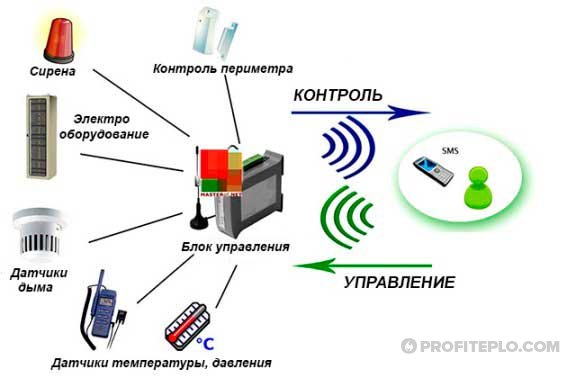 Electronic heating control unit
Electronic heating control unit Compact and easy-to-use wireless device allows:
- monitor the temperature in the premises, receiving relevant reports;
- receive key information about the operation of the heating system;
- manage the system by changing temperature regime in different rooms separately.
Conclusion
Provide remote activation boiler unit and control of the operation of all equipment is possible provided that the heating system has an automatic operating mode. In this case, it is enough to connect a GSM controller or a device with an Internet gateway to it.
